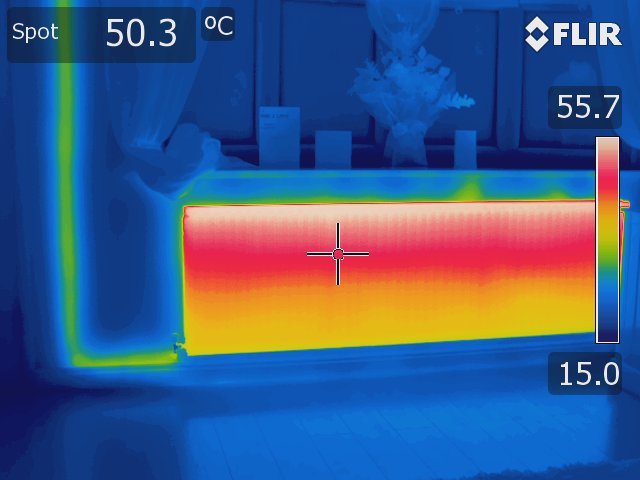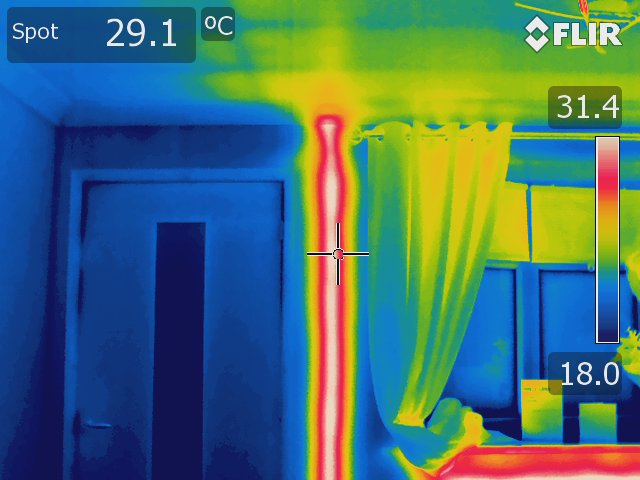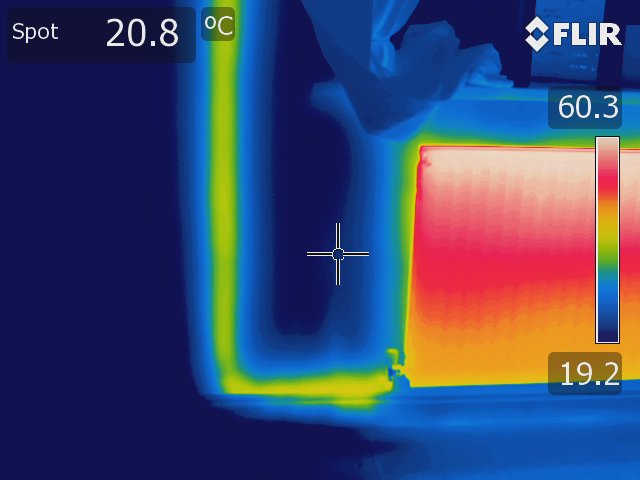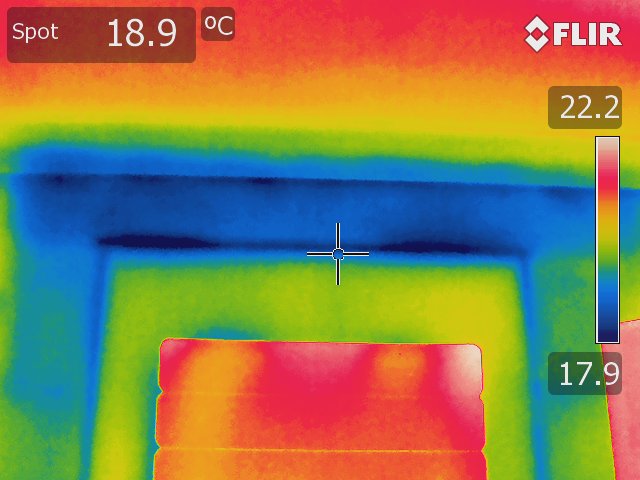
Thermal imaging cameras detect infrared energy and convert this into a thermal image allowing you to see the distribution of heat throughout the scene. PASS stocks a range of thermal imaging cameras optimised for building, heating, and plumbing diagnostics, including models by FLIR and Testo. Plumbers and heating engineers use thermal cameras to improve the ease and efficiency of jobs as they provide a fast and simple method of identifying damp, water damage, radiator blockages, and leaking pipes. Read on to discover five ways a thermal imaging camera can help you in your daily work.
Quick Links
- Detect Radiator Blockages
- See Pipes
- Locate Insulation Problems
- Find & Assess Water Damage & Damp
- Determine the Efficacy of Heating Appliances
- Further Information
1.) Detect Radiator Blockages
These two images clearly show that the top of the radiator is hotter than the bottom; this indicates that the radiator is not operating properly and needs to be bled. The scale to the right of each image illustrates the maximum and minimum temperatures measured in the field-of-view, while the spot temperature detailed at the top of the picture is the temperature at the cross. Bleeding the radiator should result in a higher maximum temperature which is more or less consistent across the whole radiator.


Rainbow vs Ironbow
The first image was captured using a Rainbow palette; the image below it was taken using an Ironbow palette. Electricians will swear by an Ironbow palette as it allows them to pick out faulty components quickly but plumbers and heating engineers often report preferring the Rainbow palette as it provides more detail. This makes it easier to see heat distribution and thereby identify blockages and, as we will come to see, determine the extent of damp, as well as pinpoint areas lacking insulation.
2.) See Pipes
Trying to find pipes is frustrating and time-consuming. Thermal cameras provide a solution to this. In the right conditions, they can be used to ‘see-through’ walls and locate pipes.



This allows you to identify pipes feeding radiators and is particularly useful for pinpointing leaking pipes in floors and walls.
3.) Locate Insulation Problems
Blue around the seal of the door illustrates that this area is cold. This suggests that the seal is not providing adequate insulation and could be the reason the room feels draughty.

Windows can also fall victim to this problem, as evidenced in the following thermal picture.

Similarly, the blue spots in the image below could signify that the wall is not as well insulated as the ceiling.

However, these blue spots could also point to the presence of damp. Cold and damp areas are at increased risk of mould.
4.) Find & Assess Water Damage & Damp
Thermal cameras provide a fast way of discovering water damage and/or damp, as well as gauging the extent or spread of this damage.

Blue denotes areas that are colder and potentially damper than red areas. These spaces may already be affected by damp or mould and/or are at high risk of developing it. Green and yellow areas are the next coldest spaces and are therefore at moderate risk of damp/mould.
A similar issue can be seen in the thermal image below.

It is worth noting that the high-sensitivity of the thermal camera used to take this image means it has picked up on the temperature difference between the breeze blocks and the cement. As a result, you can see behind the plaster wall.
Using thermal cameras to find colder, damper spaces also works when uncovering water damage.
5.) Determine the Efficacy of Heating Appliances
Red and white areas signal high thermal energy or heat. In the image below a radiator has been fitted to the opposite side of the wall. The patch of red and white shows it is working effectively. However, the fact we can see this through the wall implies that the wall itself may require further insulation.

Further Information
Thermal cameras provide a quick and easy solution for diagnosing a range of plumbing, heating, building, and electrical problems. In addition to the plumbing and heating applications outlined above, thermal cameras can be used to evaluate the efficacy of underfloor heating, and troubleshoot air conditioning and ventilation units.
For more information regarding the uses of thermal cameras, as well as advice on selecting the right model for you, please don’t hesitate to contact our sales team on 01642 931 329 or via our online form.
In the meantime, please browse our range of thermal cameras.


